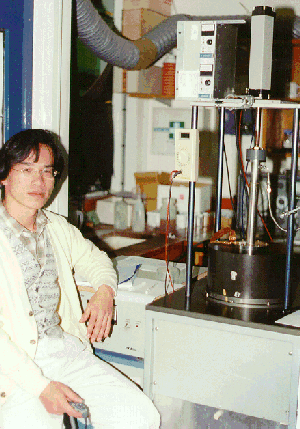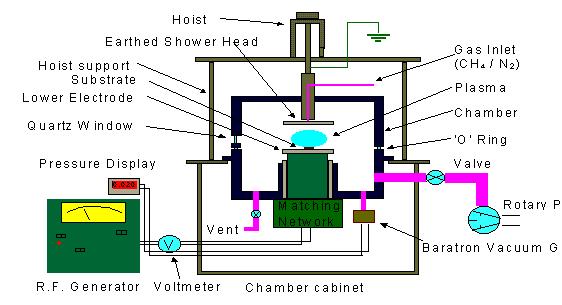 Production of Doped and Undoped DLC Films
Production of Doped and Undoped DLC Films
Deposition of Diamondlike Carbon (DLC) Films
This work was performed in the lab until ~2004, but we have now stopped working on RF plasma DLC deposition to concentrate on CVD diamond. The following details relate to the previous work.
 We worked on a project to produce diamondlike carbon (DLC) films using a 13.56 MHz radio-frequency capacitively-coupled parallel-plate plasma reactor (photo, right, schematic, below). We used methane and other hydrocarbons for the process gas at pressures of a few 10's of mTorr. The films were smooth on the nm scale, very hard (micro-indentation showed them to have Knoop hardness values of around 30 GPa), and about 0.1-0.5 μm thick (depending on deposition time and conditions). The films also contained up to 30% hydrogen, which gave them different properties to the H-free ta-C made by laser ablation.
We worked on a project to produce diamondlike carbon (DLC) films using a 13.56 MHz radio-frequency capacitively-coupled parallel-plate plasma reactor (photo, right, schematic, below). We used methane and other hydrocarbons for the process gas at pressures of a few 10's of mTorr. The films were smooth on the nm scale, very hard (micro-indentation showed them to have Knoop hardness values of around 30 GPa), and about 0.1-0.5 μm thick (depending on deposition time and conditions). The films also contained up to 30% hydrogen, which gave them different properties to the H-free ta-C made by laser ablation.

We studied the doping of these films by adding process gases such as NH3, PH3and H2S in varying proportions, in an effort to make films with semiconducting and electron-emission properties suitable for use in cold-cathode devices such as field emission displays. These films produced very promising results, with threshold voltages of less than 15 V/μm and good longevity and high current density.
Production of Carbon Phosphide Thin Films
By adding larger quantities of PH3 to the gas mixture, we were able to make thin films with P:C ratios of up to 3:1. Such films could no longer be considered as P-doped DLC, so we have termed them 'amorphous carbon phosphide' films. These films were relatively hard and had a band gap ~2 eV, and may have applications in opto-electronics. We annealled these films in vacuum to remove any impurities (such as hydrogen) and to attempt to crystallise them. The aim was to make a solid phase of crystalline carbon phosphide (or phosphorus carbide). Theoretical calculations suggested that crystalline material of stoichiometry C3P4 might be stable and have a pseudo-cubic structure. Such a material would be new to science, and may possess many useful electronic properties.
Production of Carbon-Sulfur Thin Films
Addition of H2S to the CH4 gas mixture allowed amorphous carbon films containing significant quantities of S to be deposited. Initial results indicated that S incorporation made the films more stable and more uniform, and inhibited delamination. We also determined some of the electronic properties of these highly S-doped DLC films.
Related Papers
- P.W. May, S. Höhn, W.N. Wang and N.A. Fox, "Field Emission Conduction Mechanisms in Chemical Vapour Deposited Diamond and Diamondlike Carbon Films", Appl. Phys. Letts. 72 (1998) 2182-4.
- P.W. May, S. Höhn, M.N.R. Ashfold, W.N. Wang, N.A. Fox, T.J. Davis and J.W. Steeds "Field Emission from Chemical Vapor Deposited Diamond and Diamond-like Carbon Films: Investigations of Surface Damage and Conduction Mechanisms", J. Appl. Phys. 84 (1998) 1618-1625.
- P.W. May, M-T. Kuo and M.N.R. Ashfold, "Field Emission Conduction Mechanisms in Chemical Vapour Deposited Diamond and Diamondlike Carbon Films", Diamond Relat. Mater. 8 (1999) 1490-5
- M.T. Kuo, P.W. May, A. Gunn, J.C. Marshall, M.N.R. Ashfold and K.N. Rosser, "Field Emission Studies of Nitrogen-Doped Diamond-like Carbon Films Deposited using CH4/N2/Ne and CH4/NH3/Ne RF Plasmas" Int. J. Mod. Phys. B: Condensed Matter Phys. 14 (2000) 295-300
- M-T. Kuo, P.W. May, A. Gunn, M.N.R. Ashfold and R.K. Wild, "Studies of Phosphorus Doped Diamond-like Carbon Films" Diamond Relat. Mater., 9 (2000) 1222-1227.
- M-T. Kuo, P.W. May and M.N.R. Ashfold, "Field Emission studies of low temperature thermal-annealling of nitrogen-doped hydrogenated amorphous carbon (a-C:H:N) films", Diamond Relat. Mater., 10 (2001) 889-894.
- S.R.J. Pearce, P.W. May, R.K. Wild, K.R. Hallam and P.J. Heard, "Deposition and properties of amorphous carbon phosphide films", Diamond Relat. Mater. 11 (2002) 1041-46.
- M.T. Kuo, P.W. May and M.N.R. Ashfold, "Field emission site density study of hydrogen-free amorphous carbon films", Diamond Relat. Mater. 11 (2002) 1422-28.
- J. Filik, P.W. May, S.R.J. Pearce, R.K. Wild, and K.R. Hallam, "XPS and laser Raman analysis of hydrogenated amorphous carbon films", Diamond Relat. Mater. 12 (2003) 974-78
- S.R.J. Pearce, J. Filik, P.W. May, R.K. Wild, K.R. Hallam and P.J. Heard, "The effect of ion energy on the deposition of amorphous carbon phosphide films", Diamond Relat. Mater. 12 (2003) 979-82.
- J. Filik, I.M. Lane, P.W. May, S.R.J. Pearce, K.R. Hallam, "Incorporation of Sulfur into Hydrogenated Amorphous Carbon Films", Diamond Relat. Mater. 13 (2004) 1377-1384
- F. Claeyssens, G.M. Fuge, N.L. Allan, P.W. May, S.R.J. Pearce and M.N.R. Ashfold, "Phosphorus carbide thin films: experiment and theory", Appl. Phys. A 79 (2004) 1237-1241.
